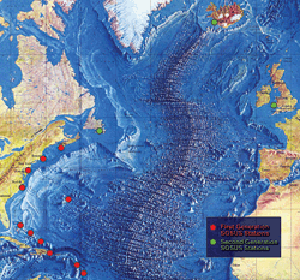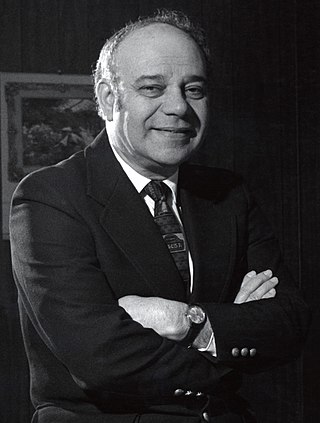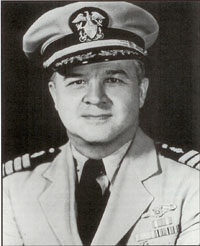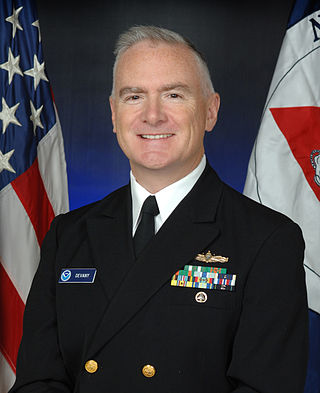Related Research Articles

The United States Naval Research Laboratory (NRL) is the corporate research laboratory for the United States Navy and the United States Marine Corps. It was founded in 1923 and conducts basic scientific research, applied research, technological development and prototyping. The laboratory's specialties include plasma physics, space physics, materials science, and tactical electronic warfare. NRL is one of the first US government scientific R&D laboratories, having opened in 1923 at the instigation of Thomas Edison, and is currently under the Office of Naval Research.

Sound Surveillance System (SOSUS) was the original name for a submarine detection system based on passive sonar developed by the United States Navy to track Soviet submarines. The system's true nature was classified with the name and acronym SOSUS classified as well. The unclassified name Project Caesar was used to cover the installation of the system and a cover story developed regarding the shore stations, identified only as a Naval Facility (NAVFAC), being for oceanographic research. The name changed to Integrated Undersea Surveillance System (IUSS) in 1985, as the fixed bottom arrays were supplemented by the mobile Surveillance Towed Array Sensor System (SURTASS) and other new systems. The commands and personnel were covered by the "oceanographic" term until 1991 when the mission was declassified. As a result, the commands, Oceanographic System Atlantic and Oceanographic System Pacific became Undersea Surveillance Atlantic and Undersea Surveillance Pacific, and personnel were able to wear insignia reflecting the mission.

The Naval Undersea Warfare Center (NUWC) is the United States Navy's full-spectrum research, development, test and evaluation, engineering and fleet support center for submarines, autonomous underwater systems, and offensive and defensive weapons systems associated with undersea warfare. It is one of the corporate laboratories of the Naval Sea Systems Command. NUWC is headquartered in Newport, Rhode Island and has two major subordinate activities: Division Newport and Division Keyport in Keyport, Washington. NUWC also controls the Fox Island facility and Gould Island. It employs more than 4,400 civilian and military personnel, with budgets over $1 billion.

Jerome Karle was an American physical chemist. Jointly with Herbert A. Hauptman, he was awarded the Nobel Prize in Chemistry in 1985, for the direct analysis of crystal structures using X-ray scattering techniques.

Vice Admiral Eli Thomas Reich was a highly decorated United States Navy officer and World War II submarine commander — the only one to sink a battleship during the war. He is buried in Arlington National Cemetery.

A Naval Surface Warfare Center (NSWC) is part of the Naval Sea Systems Command (NAVSEA) operated by the United States Navy. NAVSEA Warfare Centers supply the technical operations, people, technology, engineering services and products needed to equip and support the Fleet and meet the warfighter's needs. The Warfare Centers are the Navy's principal Research, Development, Test and Evaluation (RDT&E) assessment activity for surface ship and submarine systems and subsystems. Additionally, the Warfare Centers provide depot maintenance and In-Service Engineering support to ensure that the systems fielded today perform consistently and reliably in the future.

The Carderock Division of the Naval Surface Warfare Center is one of eight Naval Sea Systems Command (NAVSEA) Surface Warfare Centers. The headquarters, located in Carderock, Maryland, includes the historic David Taylor Model Basin. The division includes remote sites across the United States concentrating on engineering, testing and modelling ship and ship's systems for the Navy. It has about 3,200 scientists, engineers, and support personnel working in more than 40 disciplines from fundamental science to applied and in-service engineering.

The Naval Information Warfare Center Pacific, formerly the Space and Naval Warfare Systems Center Pacific, the Naval Command, Control and Ocean Surveillance Center (NCCOSC) RDT&E Division, the Space and Naval Warfare Systems Center San Diego, and the Naval Ocean Systems Center (NOSC), provides the U.S. Navy with research, development, delivery and support of integrated command, control, communications, computers, intelligence, surveillance and reconnaissance (C4ISR), cyber and space systems and capabilities across all warfighting domains. The only Naval technical center headquartered in a major fleet concentration area, NIWC Pacific manages strategic locations both in the Pacific theater and around the world.

A wet sub is a type of underwater vehicle, either a submarine or a submersible, that does not provide a dry environment for its occupants. It is also described as an underwater vehicle where occupants are exposed to ambient environment during operations. The watercraft is classified as medium-sized or small vessel. This type of submarine differs from other underwater personal transport devices by the fact that it has a hull around it and it is not a "bare bones" design.

Naval Support Activity Panama City, is a military shore installation of the United States Navy located in Bay County, in Panama City, Florida. Among its various tenant commands, it houses the Naval Surface Warfare Center Panama City Division, the Center for Explosive Ordnance Disposal & Diving (CENEODDIVE), the Navy Experimental Diving Unit (NEDU), and Coast Guard Station Panama City.

The Naval District Washington is one of eleven current naval regions responsible to Commander, Navy Installations Command for the operation and management of Naval shore installations in the Washington D.C. Metropolitan Area. The Commandant is currently the only remaining Naval Districts from the 1900s era, making it, by default the oldest of the current naval regions. The Commandant is headquartered at the Washington Navy Yard only a few yards away from the Commander, Navy Installations Command headquarters.
Robert Dexter Conrad was a United States Navy officer. He graduated from the United States Naval Academy and was commissioned as an ensign in June 1927.

Captain Charles Wesley Shilling was an American physician who was known as a leader in the field of undersea and hyperbaric medicine, research, and education. Shilling was widely recognized as an expert on deep sea diving, naval medicine, radiation biology, and submarine capabilities. In 1939, he was Senior Medical Officer in the rescue of the submarine U.S.S. Squalus.
The Navy Meritorious Civilian Service Award is awarded to civilian employees in the United States Department of the Navy for meritorious service or contributions resulting in high value or benefits for the Navy or the Marine Corps. It is conferred for a contribution that applies to a local or smaller area of operation or a project of lesser importance than would be warranted for consideration for the Navy Distinguished Civilian Service Award or the Navy Superior Civilian Service Award. It is awarded by the local activity head to U.S. Navy employees for service or contributions resulting in high value or benefit to the Department of Navy. The award consists of a certificate and citation signed by the activity head, medal and lapel emblem. The award is the third highest Navy civilian award, ranking just behind the Navy Superior Civilian Service Award, which is itself behind the Navy Distinguished Civilian Service Award.

Captain George Foote Bond was a United States Navy physician who was known as a leader in the field of undersea and hyperbaric medicine and the "Father of Saturation Diving".

The Naval Sea Systems Command (NAVSEA) is the largest of the United States Navy's five "systems commands," or materiel organizations. From a physical perspective, NAVSEA has four shipyards for shipbuilding, conversion, and repair, ten "warfare centers", the NAVSEA headquarters, located at the Washington Navy Yard, in Washington D.C., and other locations in 15 states and 3 overseas continents.

Michael S. Devany is a former vice admiral in the NOAA Commissioned Officer Corps who last served as the deputy under secretary for operations at the National Oceanic and Atmospheric Administration from January 2, 2014 to April 2016. He previously served as director of the NOAA Commissioned Officer Corps from August 13, 2012 to January 1, 2014, succeeding RADM Jonathan W. Bailey. As deputy under secretary for operations, he was NOAA’s chief operating officer. VADM Devany was responsible for the day-to-day management of NOAA’s national and international operations for oceanic and atmospheric services, research, and coastal and marine stewardship. He is a key advisor to the under secretary of commerce for oceans and atmosphere/NOAA administrator on NOAA program and policy issues. Devany was the first NOAA Corps officer to achieve the rank of vice admiral since VADM Henry A. Karo in 1965, and the second NOAA Corps officer overall. Devany retired from NOAA in April 2016 after over 30 years of combined uniformed service.
Project Nobska was a 1956 summer study on anti-submarine warfare (ASW) for the United States Navy ordered by Chief of Naval Operations Admiral Arleigh Burke. It is also referred to as the Nobska Study, named for its location on Nobska Point near the Woods Hole Oceanographic Institution (WHOI) on Cape Cod, Massachusetts. The focus was on the ASW implications of nuclear submarines, particularly on new technologies to defend against them. The study was coordinated by the Committee on Undersea Warfare (CUW) of the National Academy of Sciences (NAS). It was notable for including 73 representatives from numerous organizations involved in submarine design, submarine-related fields, and weapons design, including senior scientists from the Atomic Energy Commission's nuclear weapons laboratories. Among the participants were Nobel laureate Isidor Rabi, Paul Nitze, and Edward Teller. The study's recommendations influenced all subsequent US Navy submarine designs, as well as submarine-launched ASW tactical nuclear weapons until this weapon type was phased out in the late 1980s. New lightweight and heavyweight anti-submarine torpedo programs were approved. Although not on the initial agenda, the Polaris submarine-launched ballistic missile (SLBM) was determined to be capable of implementation at this conference. Within five years Polaris would dramatically improve the US Navy's strategic nuclear deterrent capability.
Arthur Bernard Baggeroer is an American Electrical Engineer and emeritus Ford Professor of Engineering in the Departments of Mechanical Engineering and Electrical Engineering & Computer Science at the Massachusetts Institute of Technology.